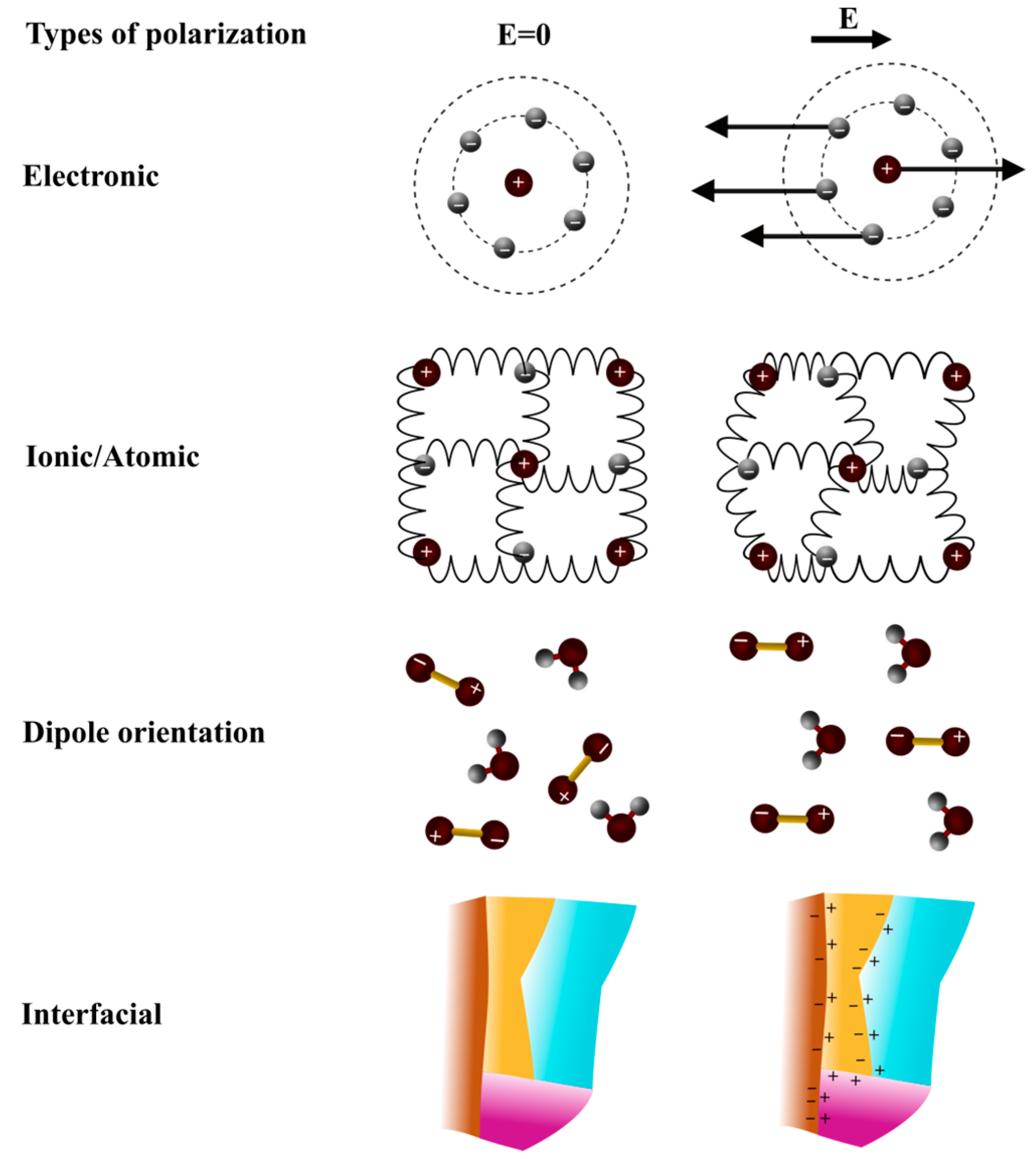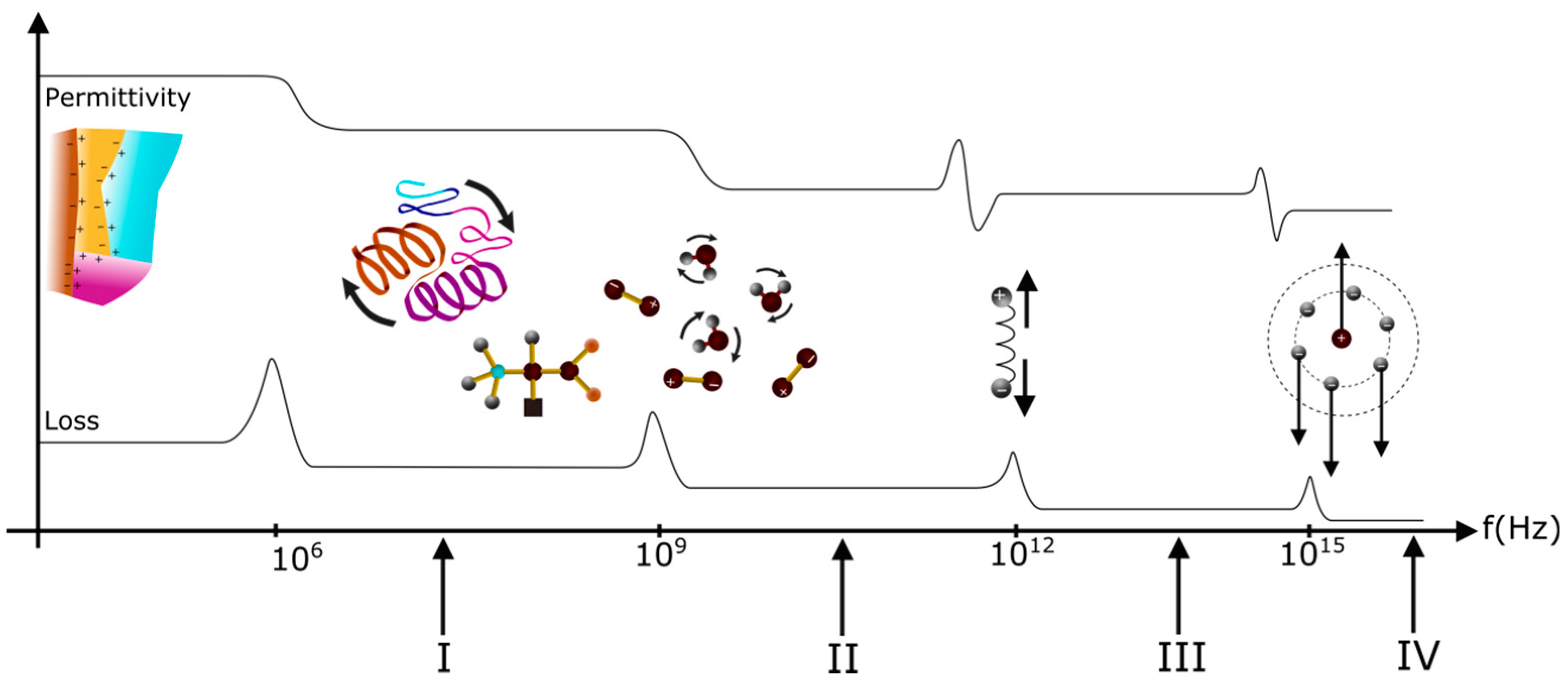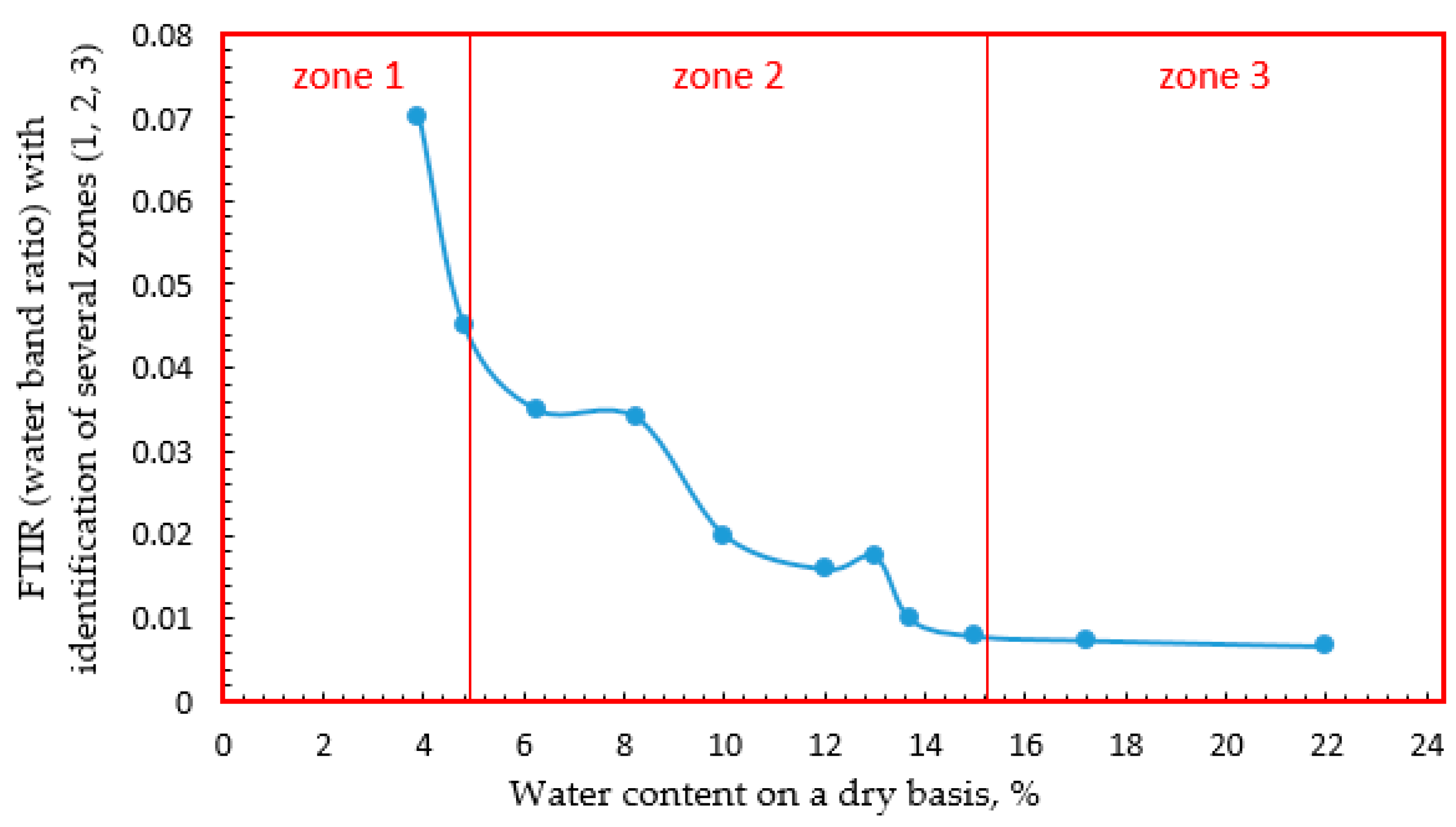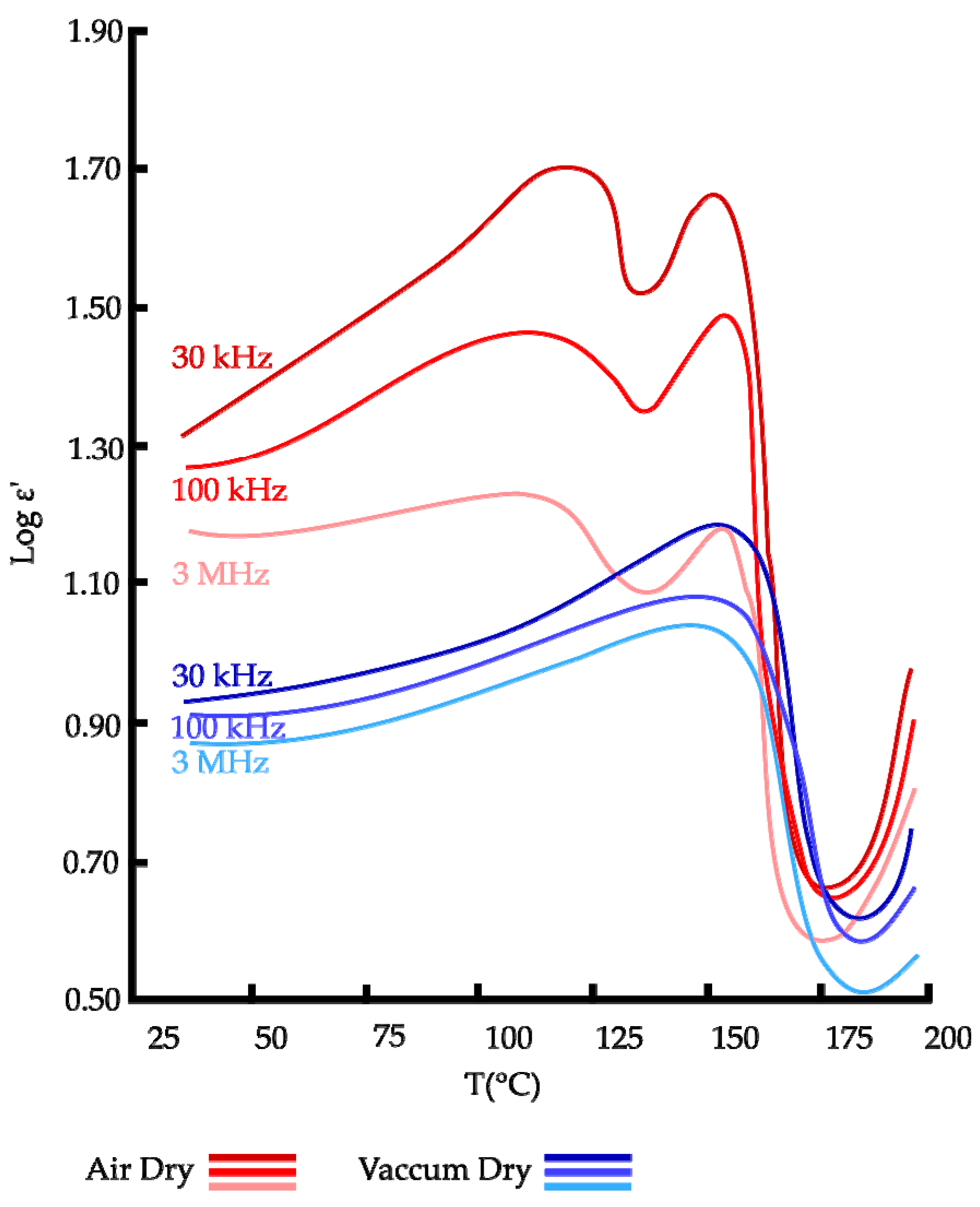A Review: Origins of the Dielectric Properties of Proteins and Potential Development as Bio-Sensors
Abstract
:1. Introduction
2. Dielectric Properties of Polymers
2.1. Origins of Dielectric Properties of Polymeric Materials
2.2. Dielectric Properties of the Protein-Based Materials
2.3. Frequency
3. Factors Affecting Dielectric Properties of Proteins
3.1. Moisture Content
3.1.1. Impact of Moisture Content on Dielectric Parameters
- Water bound by high-energy sorption centers (from 0 to 0.055 g·g−1 (0%–10% RH)). This type of water, existing at charged residues and inside the triple helix, plays a major role in protein stabilization, due the intramolecular hydrogen bonds.
- Structural water (from 0.055 to 0.14 g·g−1 (10%–40% RH)). This is the water directly bound to the protein (represented by both inside as outside helical fragments).
- Polymolecular layer (from 0.14 to 0.37 g·g−1 (40%–90% RH)). In excess of bound water concentration of 0.14 g·g−1, the monomolecular layer transforms into a polymolecular layer, which covers the triple helix structure.
- Free water (above 0.37 g·g−1 (90% RH)).
3.1.2. Mechanical Properties of Protein Films
- Brittle behavior without any plastic deformation (0%–7% water);
- Brittle behavior with weak plastic deformation without decrease of cross-section area, which precedes the fracture (7%–14% water);
- Brittle behavior without any plastic deformation (14%–22% water).
3.1.3. Structural Consideration
3.1.4. Alternative Method for Molecular Consideration
3.2. Other Plasticizer Content than Water Content
3.2.1. Plasticizer Content Effect on Dielectric Parameters Evolution
3.2.2. Effect of Plasticizer on Mechanical Properties of Protein Films and FTIR Spectra
3.3. Temperature
3.3.1. Temperature Dependence of Dielectric Parameters
3.3.2. Dielectric Parameters and Glass Transition Temperature
3.3.3. Impact of Temperature on Protein Films at Molecular Level
3.4. Cross-Linking Agent
3.5. Gas and Volatile Content
4. Potential Development of Proteins as Biosensors
5. Conclusions
Acknowledgments
Conflicts of Interest
References
- Warshel, A.; Russell, S. Calculations of electrostatic interactions in biological systems and in solutions. Q. Rev. Biophys. 1984, 17, 283–422. [Google Scholar] [CrossRef] [PubMed]
- Matthew, J. Electrostatic effects in proteins. Annu. Rev. Biophys. Biophys. Chem. 1985, 14, 387–417. [Google Scholar] [CrossRef] [PubMed]
- Van Belle, D.; Couplet, I.; Prevost, M.; Wodak, S. Calculations of electrostatic properties in proteins analysis of contributions from induced protein dipoles. J. Mol. Biol. 1987, 198, 721–735. [Google Scholar] [CrossRef]
- Li, W.; Dobraszczyk, B.; Schofield, J. Stress relaxation behavior of wheat dough, gluten and gluten protein fractions. Cereal Chem. 2003, 80, 333–338. [Google Scholar] [CrossRef]
- Sham, Y.; Muegge, I.; Warshel, A. The effect of protein relaxation on charge-charge interactions and dielectric constants of proteins. Biophys. J. 1998, 74, 1744–1753. [Google Scholar] [CrossRef]
- Garcia-Moreno, B.; Dwyer, J.J.; Gittis, A.G.; Lattman, E.E.; Spencer, D.S.; Stites, W.E. Experimental measurement of the effective dielectric in the hydrophobic core of a protein. Biophys. Chem. 1997, 64, 211–224. [Google Scholar] [CrossRef]
- Simonson, T.; Perahia, D. Dielectric properties of proteins from simulations: Tools and techniques. Comput. Phys. Commun. 1995, 91, 291–303. [Google Scholar] [CrossRef]
- Dubois, J.-C. Propriétés diélectriques des polymères. Tech. L’ingénieur 2012, 33, 1–21. (In French) [Google Scholar]
- Bonincontro, A.; Mari, C.; Mengoni, M.; Risuleo, G. A study of the dielectric properties of E. coli ribosomal RNA and proteins in solution. Biophys. Chem. 1997, 67, 43–50. [Google Scholar] [CrossRef]
- Ryyniinen, S. The electromagnetic properties of food materials: A review of the basic principles. J. Food Eng. 1995, 26, 409–429. [Google Scholar] [CrossRef]
- Figueiró, S.; Macêdo, A.A.; Melo, M.R.; Freitas, A.L.; Moreira, R.; de Oliveira, R.; Góes, J.; Sombra, A.S. On the dielectric behaviour of collagen-algal sulfated polysaccharide blends: Effect of glutaraldehyde crosslinking. Biophys. Chem. 2006, 120, 154–159. [Google Scholar] [CrossRef] [PubMed]
- Bonincontro, A.; Risuleo, G. Dielectric spectroscopy as a probe for the investigation of conformational properties of proteins. Spectrochim. Acta Part A Mol. Biomol. Spectrosc. 2003, 59, 2677–2684. [Google Scholar] [CrossRef]
- Gontard, N.; Thibault, R.; Cuq, B.; Guilbert, S.; Breton, J.F. Influence of relative humidity and film composition on oxygen and carbon dioxide permeabilities of edible films. J. Agric. Food Chem. 1996, 44, 1064–1069. [Google Scholar] [CrossRef]
- Mujica-Paz, H.; Gontard, N. Oxygen and carbon dioxide permeability of wheat gluten film: Effect of relative humidity and temperature. J. Agric. Food Chem. 1997, 80, 4101–4105. [Google Scholar] [CrossRef]
- Yoshizawa, S.; Arakawa, T.; Shiraki, K. Dependence of ethanol effects on protein charges. Int. J. Biol. Macromol. 2014, 68, 169–172. [Google Scholar] [CrossRef] [PubMed]
- Yoshikawa, H.; Hirano, A.; Arakawa, T.; Shiraki, K. Mechanistic insights into protein precipitation by alcohol. Int. J. Biol. Macromol. 2012, 50, 865–871. [Google Scholar] [CrossRef] [PubMed]
- Yoshikawa, H.; Hirano, A.; Arakawa, T.; Shiraki, K. Effects of alcohol on the solubility and structure of native and disulfide-modified bovine serum albumin. Int. J. Biol. Macromol. 2012, 50, 1286–1291. [Google Scholar] [CrossRef] [PubMed]
- Mukhopadhyay, S.C. Intelligent Sensing, Instrumentation and Measurements; Springer: Berlin, Germany, 2013. [Google Scholar]
- Realini, C.E.; Marcos, B. Active and intelligent packaging systems for a modern society. Meat Sci. 2014, 98, 404–419. [Google Scholar] [CrossRef] [PubMed]
- Johns Hopkins University Applied Physics Laboratory A colorimetric Sensor of Food Spoilage Based on a Molecularly Imprinted Polymer. Available online: http://www.jhuapl.edu/ott/technologies/technology/articles/P01491.asp (accessed on 9 June 2016).
- Crack, J.C.; Green, J.; Hutchings, M.I.; Thomson, A.J.; Le Brun, N.E. Bacterial iron-sulfur regulatory proteins as biological sensor-switches. Antioxid. Redox Signal. 2012, 17, 1215–1231. [Google Scholar] [CrossRef] [PubMed]
- Anees, P.; Sreejith, S.; Ajayaghosh, A. Self-assembled near-infrared dye nanoparticles as a selective protein sensor by activation of a dormant fluorophore. J. Am. Chem. Soc. 2014, 136, 13233–13239. [Google Scholar] [CrossRef] [PubMed]
- Hoffman, R.M. Fluorescent proteins as visible in vivo sensors. Prog. Mol. Biol. Transl. Sci. 2013, 113, 389–402. [Google Scholar] [PubMed]
- Barringer, S.A.; Fleischmann, A.M.; Davis, E.A.; Gordon, J. The dielectric properties of whey protein as indicators of change in polymer mobility. Food Hydrocoll. 1995, 9, 343–348. [Google Scholar] [CrossRef]
- Castro-Giráldez, M.; Botella, P.; Toldrá, F.; Fito, P. Low-frequency dielectric spectrum to determine pork meat quality. Innov. Food Sci. Emerg. Technol. 2010, 11, 376–386. [Google Scholar] [CrossRef]
- Von Hippel, A. Les Diélectriques et Leurs Applications; Dunod: Paris, France, 1961. (In French) [Google Scholar]
- Castro-Giráldez, M.; Fito, P.J.; Fito, P. Application of microwaves dielectric spectroscopy for controlling pork meat (Longissimus dorsi) salting process. J. Food Eng. 2010, 97, 484–490. [Google Scholar] [CrossRef]
- Pethig, R. Dielctric and Electronic Properties of Biological Materials; John Wiley & Sons: New York, NY, USA, 1979. [Google Scholar]
- Haynes, L.C.; Locke, J.P. Microwave permittivities of cracker dough, starch and gluten. J. Microw. Power Electromagn. Energy 1995, 30, 124–131. [Google Scholar] [CrossRef]
- Huang, V.; Mclntyre, F.; Haynes, L.; Levine, H.; Slade, L. Glass transitions in starch, gluten, and bread as measured by TMA, TSC, and dielectric spectroscopy methods. J. Therm. Anal. 1996, 47, 1289–1298. [Google Scholar] [CrossRef]
- Ahmed, J.; Ramaswamy, H.S.; Raghavan, V.G.S. Dynamic viscoelastic, calorimetric and dielectric characteristics of wheat protein isolates. J. Cereal Sci. 2008, 47, 417–428. [Google Scholar] [CrossRef]
- Orlowska, S. Conception de Prédiction des Caractéristiques à Deux et Trios Phases par la Modélisation, L’école Doctorale Electronique Electrotechnique, Automatique de Lyon; Ecole doctorale Electronique, Electrotechnique, Automatique: Lyon, France, 2003. (In French) [Google Scholar]
- Momany, F.; Sessa, D.; Lawton, J.; Selling, G.; Hamaker, S.; Willett, J. Structural characterization of α-Zein. J. Agric. Food Chem. 2006, 54, 543–547. [Google Scholar] [CrossRef] [PubMed]
- Gennadios, A. Protein-Based Films and Coatings; Gennadios, A., Ed.; CRC Press: Boca Raton, FL, USA, 2002. [Google Scholar]
- Marzec, E.; Pietrucha, K. The effect of different methods of cross-linking of collagen on its dielectric properties. Biophys. Chem. 2008, 132, 89–96. [Google Scholar] [CrossRef] [PubMed]
- Iwamoto, S.; Kumagai, H.; Hayashi, Y.; Miyawaki, O. Conductance and relaxations of gelatin films in glassy and rubbery states. Int. J. Biol. Macromol. 1999, 26, 345–351. [Google Scholar] [CrossRef]
- Guilbert, S.; Morel, M.; Cuq, B. Protéines matériaux. In La Chimie Verte; Lavoisier: Cachan, France, 2006. [Google Scholar]
- Pitera, J.W.; Falta, M.; van Gunsteren, W.F. Dielectric properties of proteins from simulation: The effects of solvent, ligands, pH, and temperature. Biophys. J. 2001, 80, 2546–2555. [Google Scholar] [CrossRef]
- Schrieber, R.; Gareis, H. Gelatine Handbook: Theory and Industrial Practice; Wiley-VCH Verlag GmbH & Co. KGaA: Weinheim, Germany, 2007. [Google Scholar]
- Almutawah, A.; Barker, S.A.; Belton, P.S. Hydration of gluten: A dielectric, calorimetric, and fourier transform infrared study. Biomacromolecules 2007, 8, 1601–1606. [Google Scholar] [CrossRef] [PubMed]
- Zahra Rizvi, T.; Abdullah Khan, M. Temperature-dependent dielectric properties of slightly hydrated horn keratin. Int. J. Biol. Macromol. 2008, 42, 292–297. [Google Scholar] [CrossRef] [PubMed]
- Gillgren, T.; Barker, S.A.; Belton, P.S.; Georget, D.M.R.; Stading, M. Plasticization of zein: A thermomechanical, FTIR, and dielectric study. Biomacromolecules 2009, 10, 1135–1139. [Google Scholar] [CrossRef] [PubMed]
- Wolf, M.; Gulich, R.; Lunkenheimer, P.; Loidl, A. Relaxation dynamics of a protein solution investigated by dielectric spectroscopy. Biochim. Biophys. Acta 2012, 1824, 723–730. [Google Scholar] [CrossRef] [PubMed]
- Lima, C.G.A.; de Oliveira, R.S.; Figueiró, S.D.; Wehmann, C.F.; Góes, J.C.; Sombra, A.S.B. DC conductivity and dielectric permittivity of collagen-chitosan films. Mater. Chem. Phys. 2006, 99, 284–288. [Google Scholar] [CrossRef]
- Matko, V.; Donlagic, D. Sensor for high-air-humidity measurement. IEEE Trans Instrum. Meas. 1996, 45, 561–563. [Google Scholar] [CrossRef]
- Matko, V. Next generation AT-Cut quartz crystal sensing devices. Sensors 2011, 11, 4474–4482. [Google Scholar] [CrossRef] [PubMed]
- Matko, V.; Milanovic, M. Temperature-compensated capacitance-frequency converter with high resolution. Sens. Actuators A Phys. 2014, 220, 262–269. [Google Scholar] [CrossRef]
- Bonfig, K.W. Das Direkte Digitale Messverfahren als Grundlage einfacher und dennoch genauer und storsicherer Sensoren. Sensors 1988, 3, 103–108. [Google Scholar]
- Venkatesh, M.S.; Raghavan, G.S.V. An overview of microwave processing and dielectric properties of agri-food materials. Biosyst. Eng. 2004, 88, 1–18. [Google Scholar] [CrossRef]
- Man Suherman, P.; Taylor, P.; Smith, G. Low frequency dielectric study on hydrated ovalbumin. J. Non-Cryst. Solids 2002, 305, 317–321. [Google Scholar] [CrossRef]
- Jonscher, A.K. Presentation and interpretation of dielectric data. Thin Solid Films 1978, 50, 187–204. [Google Scholar] [CrossRef]
- Dissado, A.; Hill, M.; Group, T.D.; Place, P. Influence of adsorbed water on the dielectric response of a ceramic material. J. Chem. Soc. 1984, 80, 325–340. [Google Scholar]
- Vackier, M.C.; Hills, B.P.; Rutledge, D.N. An NMR relaxation study of the state of water in gelatin gels. J. Magn. Reson. 1999, 138, 36–42. [Google Scholar] [CrossRef] [PubMed]
- Yakimets, I.; Wellner, N.; Smith, A.C.; Wilson, R.H.; Farhat, I.; Mitchell, J. Mechanical properties with respect to water content of gelatin films in glassy state. Polymer (Guildf) 2005, 46, 12577–12585. [Google Scholar] [CrossRef]
- Cuq, B.; Gontard, N.; Aymard, C.; Guilbert, S. Relative humidity and temperature effects on mechanical and water vapor barrier properties of myofibrillar protein-based films. Polym. Gels Netw. 1997, 5, 1–15. [Google Scholar] [CrossRef]
- Belton, P.S.; Colquhoun, I.J.; Grant, A.; Wellner, N.; Field, J.M.; Shewry, P.R.; Tatham, A.S. FTIR and NMR studies on the hydration of a high-M(r) subunit of glutenin. Int. J. Biol. Macromol. 1995, 17, 74–80. [Google Scholar] [CrossRef]
- Kusanagi, H.; Yukawa, S. Fourier transform infrared spectroscopic studies of water molecules sorbed in solid polymers. Polymer (Guildf) 1994, 35, 5637–5640. [Google Scholar] [CrossRef]
- Matsuguchi, M.; Umeda, S.; Sadaoka, Y.; Sakai, Y. Characterization of polymers for a capacitive-type humidity sensor based on water sorption behavior. Sens. Actuators B 1998, 49, 179–185. [Google Scholar] [CrossRef]
- Paley, M.S.; McGill, R.A.; Howard, S.C.; Wallace, S.E.; Harris, J.M. Solvatochromism: A new method for polymer characterization. Macromolecules 1990, 23, 4557–4564. [Google Scholar] [CrossRef]
- Guilbert, S.; Gontard, N.; Morel, M.; Chalier, P.; Micard, V.; Redl, A. Formation and properties of wheat gluten films and coatings. In Protein-Based Films and Coatings; CRC Press: Boca Raton, FL, USA, 2002; pp. 69–122. [Google Scholar]
- Bergo, P.; Moraes, I.C.F.; Sobral, P.J.A. Infrared spectroscopy, mechanical analysis, dielectric properties and microwave response of pigskin gelatin films plasticized with glycerol. Food Biosci. 2013, 1, 10–15. [Google Scholar] [CrossRef]
- Bergo, P.; Sobral, P.J.A. Effects of plasticizer on physical properties of pigskin gelatin films. Food Hydrocoll. 2007, 21, 1285–1289. [Google Scholar] [CrossRef]
- Bergo, P.; Moraes, I.C.F.; Sobral, P.J.A. Effects of plasticizer concentration and type on moisture content in gelatin films. Food Hydrocoll. 2013, 32, 412–415. [Google Scholar] [CrossRef]
- Al-Hassan, A.A.; Norziah, M.H. Starch-gelatin edible films: Water vapor permeability and mechanical properties as affected by plasticizers. Food Hydrocoll. 2012, 26, 108–117. [Google Scholar] [CrossRef]
- Georget, D.M. R.; Belton, P.S. Effects of temperature and water content on the secondary structure of wheat gluten studied by FTIR spectroscopy. Biomacromolecules 2006, 7, 469–475. [Google Scholar] [CrossRef] [PubMed]
- Robinson, R.; Stockes, R. Electrolytes Solutions; Academic Press: New York, NY, USA, 1959. [Google Scholar]
- Sobral, P.J.A.; Menegalli, F.C.; Hubinger, M.D.; Roques, M.A. Mechanical, water vapor barrier and thermal properties of gelatin based edible films. Food Hydrocoll. 2001, 15, 423–432. [Google Scholar] [CrossRef]
- Hochstetter, A.; Talja, R.A.; Helén, H.J.; Hyvönen, L.; Jouppila, K. Properties of gluten-based sheet produced by twin-screw extruder. LWT Food Sci. Technol. 2006, 39, 893–901. [Google Scholar] [CrossRef]
- Pietrucha, K.; Marzec, E. Dielectric properties of the collagen-glycosaminoglycans scaffolds in the temperature range of thermal decomposition. Biophys. Chem. 2005, 118, 51–56. [Google Scholar] [CrossRef] [PubMed]
- Pena-Serna, C.; Lopes-Filho, J.F. Influence of ethanol and glycerol concentration over functional and structural properties of zein-oleic acid films. Mater. Chem. Phys. 2013, 142, 580–585. [Google Scholar] [CrossRef]
- Larsson, M.; Hjärtstam, J.; Berndtsson, J.; Stading, M.; Larsson, A. Effect of ethanol on the water permeability of controlled release films composed of ethyl cellulose and hydroxypropyl cellulose. Eur. J. Pharm. Biopharm. 2010, 76, 428–432. [Google Scholar] [CrossRef] [PubMed]
- Bibi, F.; Guillaume, C.; Sorli, B.; Gontard, N. Plant polymer as sensing material: Exploring environmental sensitivity of dielectric properties using interdigital capacitors at ultra high frequency. Sens. Actuators B Chem. 2016, 230, 212–222. [Google Scholar] [CrossRef]
- Pochat-Bohatier, C.; Sanchez, J.; Gontard, N. Influence of relative humidity on carbon dioxide sorption in wheat gluten films. J. Food Eng. 2006, 77, 983–991. [Google Scholar] [CrossRef]
- Adhikari, B.; Majumdar, S. Polymers in sensor applications. Prog. Polym. Sci. 2004, 29, 699–766. [Google Scholar] [CrossRef]
- Bibi, F.; Guillaume, C.; Vena, A.; Gontard, N.; Sorli, B. Wheat gluten, a bio-polymer layer to monitor relative humidity in food packaging: Electric and dielectric characterization. Sens. Actuators A Phys. 2016, 247, 355–367. [Google Scholar] [CrossRef]
- Kim, Y.; Jung, B.; Lee, K.; Park, H. Capacitive humidity sensor design based on anodic aluminium oxide. Sens. Actuators B Chem. 2009, 141, 441–446. [Google Scholar] [CrossRef]
- Opera, A.; Barsan, N.; Weimar, U.; Bauersfeld, M.L.; Ebling, D.; Wollenstein, J. Capacitive humidity sensors on flexible RFID labels. Sens. Actuators B Chem. 2007, 132, 2039–2042. [Google Scholar]
- Rivadeneyra, A.; Fernandez-Salmeron, J.; Agudo, M.; Lopez-Villanueva, J.A.; Capitan-Vallvey, L.F.; Palma, A.J. Design and characterization of a low thermal drift capacitive humidity sensor by inkjet-printing. Sens. Actuators B Chem. 2014, 195, 123–131. [Google Scholar] [CrossRef]
- Molina-Lopez, F.; Briand, D.; De Rooij, N.F. All additive inkjet printed humidity sensors on plastic substrate. Sens. Actuators B Chem. 2012, 166/167, 212–222. [Google Scholar] [CrossRef]
- Lacquet, B.M.; Swart, P.L. A new electrical circuit model for porous dielectric humidity sensors. Sens. Actuators B Chem. 1993, 17, 41–46. [Google Scholar] [CrossRef]
- Hermans, E.C.M. CO, CO2, CH4 and H2O sensing by polymer covered interdigitated electrode structures. Sens. Actuators 1984, 5, 181–186. [Google Scholar] [CrossRef]
- Balde, M.; Vena, A.; Sorli, B. Fabrication of porous anodic aluminium oxide layers on paper for humidity sensors. Sens. Actuators B Chem. 2015, 220, 829–839. [Google Scholar] [CrossRef]
- Xie, W.; Liu, B.; Xiao, S.; Li, H.; Wang, Y.; Cai, D.; Wang, D.; Wang, L.; Liu, Y.; Li, Q.; et al. High performance humidity sensors based on CeO2 nanoparticles. Sens. Actuators B Chem. 2015, 215, 125–132. [Google Scholar] [CrossRef]





| Protein Type | Frequency | Temperature | ε′ | ε″ | Reference |
|---|---|---|---|---|---|
| Gelatin | 1 MHz | 25 | 12 | 0.2 | [11] |
| Gluten | 1 MHz | 15 | 7 | 0.08 | [40] |
| Keratin | 3 MHz | 50 | 8 | 0.2 | [41] |
| Zein | 1 MHz | 25 | 7 | 8.10−2 | [42] |
| Material | Method Used | Frequency | % Relative Humidity (T/°C) | % Water Content (Dry Basis) | ε′ | ε″ | Ref. |
|---|---|---|---|---|---|---|---|
| Gluten (Dough) | Open ended coaxial cable connected to a probe | 915 MHz | - (30) | 92.3 | 27.3 | 8.6 | [31] |
| 2450 MHz | - (30) | 92.3 | 24.2 | 8.1 | |||
| Gluten (Dough) | Open ended coaxial line probe | 2000 MHz | - (22) | 38.8 | 5 | 2.5 | [30] |
| 16,000 MHz | - (22) | 38.8 | 3.5 | 2.25 | |||
| Gluten (powder) | Open ended coaxial line probe | 200 MHz | - (22) | 63.9 | 22 | 79.5 | [29] |
| 10,000 MHz | - (22) | 63.9 | 12.5 | 7.95 | |||
| 20,000 MHz | - (22) | 38.8 | 3.5 | 0.79 | |||
| 3 MHz | ~0 (50) | - | 15.8 | 2 | |||
| Collagen (films) | - | 1 MHz | - | - | 3.94 | - | [44] |
| 1000 MHz | - | - | 2.71 | - |
| Material | Frequency Range (Hz) | Temperature (°C) | ε′ | ε″ | Reference |
|---|---|---|---|---|---|
| Keratin | 30–3 × 106 | 50 | 10–8 | 2–0.2 | [41] |
| Gluten | 10−2–106 | 15 | 7 | 0.1–0.08 | [40] |
| Zein | 10−2–106 | 25 | 7–5 | 1–0.1 | [42] |
| Material | Frequency Range (Hz) | Temperature (°C) | Relative Humidity (%) | ε′ | ε″ | Reference |
|---|---|---|---|---|---|---|
| Keratin | 30–3 × 106 | 50 | 50 | 250–13 | 100–2 | [41] |
| Gluten | 10−2–106 | 15 | 60 | 108–102 | 108–103 | [40] |
| Zein | 10−2–106 | 25 | 84 | 106–10 | 106–1 | [42] |
| Material | Type | Max. Sensitivity | Max. Hysteresis | Application |
|---|---|---|---|---|
| Wheat gluten (film) [75] | Natural polymer | 162.0 ± 0.6 fF/%RH between 90% and 95% RH | 7% at 90% RH | Agrifood sector-Passive RFID |
| Anodic aluminum oxide [76] | Oxide | 483 fF/%RH | 30% at 92% RH | Humidity sensors |
| Polyethylene-naphthalate and polyimide foils [77] | Synthetic polymer | 21 fF/%RH | - | Intelligent RFID |
| Polyimide [78] | Synthetic polymer | 4.5 fF/%RH | 10% at 50% RH | Humidity sensor for RFID for monitoring environmental humidity |
| Cellulose acetate butyrate [79] | Synthetic polymer | 1.5 ± 0.03 fF/%RH | 20% at 20% RH and 30% RH | Low cost sensor arrays and disposable sensing platforms |
| Porous aluminum oxide [80] | Oxide | 312.5 fF/%RH | - | - |
| Polyphenylacetylene (PPA) [81] | Synthetic polymer | 10 fF/%RH | - | - |
| Anodic Aluminum oxide [82] | Oxide | 4200 fF/%RH | 16.5% at 70% RH | Humidity sensors |
| Cerium(IV) oxide [83] | Oxide | 111 pF/%RH | 1% at 45%RH | Humidity sensors |
© 2016 by the authors; licensee MDPI, Basel, Switzerland. This article is an open access article distributed under the terms and conditions of the Creative Commons Attribution (CC-BY) license (http://creativecommons.org/licenses/by/4.0/).
Share and Cite
Bibi, F.; Villain, M.; Guillaume, C.; Sorli, B.; Gontard, N. A Review: Origins of the Dielectric Properties of Proteins and Potential Development as Bio-Sensors. Sensors 2016, 16, 1232. https://doi.org/10.3390/s16081232
Bibi F, Villain M, Guillaume C, Sorli B, Gontard N. A Review: Origins of the Dielectric Properties of Proteins and Potential Development as Bio-Sensors. Sensors. 2016; 16(8):1232. https://doi.org/10.3390/s16081232
Chicago/Turabian StyleBibi, Fabien, Maud Villain, Carole Guillaume, Brice Sorli, and Nathalie Gontard. 2016. "A Review: Origins of the Dielectric Properties of Proteins and Potential Development as Bio-Sensors" Sensors 16, no. 8: 1232. https://doi.org/10.3390/s16081232
APA StyleBibi, F., Villain, M., Guillaume, C., Sorli, B., & Gontard, N. (2016). A Review: Origins of the Dielectric Properties of Proteins and Potential Development as Bio-Sensors. Sensors, 16(8), 1232. https://doi.org/10.3390/s16081232





